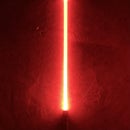Introduction: Obi-Wan Kenobi Lightsaber Hilt From Star Wars Episode III: Revenge of the Sith | Extremely Precise Replica 3D Printed PLA-Metal Composite
You can either watch the video or scroll down and read the tutorial:
Supplies
Tools
- A 3D Printer
- A 0.6mm Nozzle (preferably steel as it will last longer against the metal particles): https://amzn.to/3Y53xQT
Filament
- Black Plastic Filament: https://amzn.to/3XLkhw1
- Steel Filament: https://proto-pasta.com/products/stainless-steel-pla?variant=1204178344&aff=188
- Copper Filament: https://proto-pasta.com/products/copper-metal-composite-htpla?variant=33706473455747&aff=188
- Brass Filament: https://proto-pasta.com/products/brass-metal-composite-htpla?variant=33706471653507&aff=188
Other
- Super Glue: https://amzn.to/3N4LcxX
The above links are Affiliate Links, meaning that if you buy the items they link to, I'll receive a small commission (at no extra cost to you). Thanks!
Step 1: 3D Printing
You can pick up the files here: https://www.thingiverse.com/thing:6783164
You only need to download the .zip file, which contains all of the necessary models neatly laid out in their folders. (I only uploaded the pommel .stl because Thingiverse required it.)
Each 'section' is in its own folder.
Each model ends in _Material (eg _Brass, _Plastic) so you know what material it should be printed from.
Once you've printed everything, I recommend assembling each 'section' before putting the sections together, to make sure you don't accidentally keep one section from being able to be assembled.
I did not use any supports for any of the models, they're designed so that supports aren't needed.
Most of the parts should be printed at 0.1mm layer thickness, but you can get away with 0.2 (maybe even 0.3) for the grip, the main part of the activator, the main part of the booster, and the pommel.
Step 2: Sanding and Polishing
You can see the pictures above to help understand what your parts should look like before and after.
The black plastic pieces don't need to be sanded, only the metal ones.
The metal pieces don't look like much until you sand/polish them, and you do have to spend some time to get them to look like metal.
I sanded mine with 220 grit (to remove layer lines), then 320 grit, and finally 2000 grit (for some pieces I also used 5000 and 7000 grit as well).
Step 3: Assembly
Start at the top. The two parts of the emitter slide together tightly, so don't test fit them before adding glue (or you won't be able to disassemble it). Just add some glue to the bottom of the small, detailed emitter center and slide it into the bigger part.
Then do the copper. The copper neck is in two parts, so just add some glue inside the cup shaped one (at the bottom) and slide the parts together. You'll notice that one side of the copper is longer than the other; that's the side that goes into the emitter, so add some glue on the end and glue it into the emitter.
Next up: the brass. Add some glue to the interior of the ring part and slide it onto the (very tight) cylinder of the stick part. The copper goes into the hole in the top of the brass piece.
Add some glue to the bottom of the brass and slide it into the top of the grip (the top is bevelled; the bottom ends in a cylinder).
For the activator, the first thing you want to do is slide the black spacer into the main silver part (the curved part of the spacer faces inward). Then add some glue on top of the black spacer and slide the brass activator plate into the slot (make sure it's centered before you slide it in, it breaks very easily). The top of the brass activator should be flush with the top of the slot. Add some glue around the copper pin (closer to the flat end) and slide it into the upper activator slot (the top of the activator is the part that has a slightly narrower cylinder) and hold it until the glue dries. Add some glue to around the silver bolt and slide it into the lower hole).
Add some glue around the grip's cylinder and slide it into the activator.
Take the top of the CoverTech wheel (there are two parts to the CoverTech wheel: the top, which has a wide cylinder and a post sticking up from it, and the bottom, which is just a ring) and add some glue around the end of the post, then slide the bottom ring on until the ring is flush with the bottom of the post (leaving a gap in between the ring and the top part's wider cylinder, that's how the CoverTech wheel works).
Add some glue to the bottom of the CoverTech wheel (the ring and the post that is now flush with it) and place it in the cutout on the booster section.
Add some glue to the top of the booster section and slide it into the activator.
Add some glue to the top of the pommel and slide it into the booster.
Your saber is now complete!




